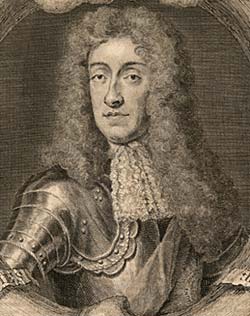Background to the Invasion
The last Stuart King of Britain was James VII of Scotland and II of England (reigned 1685-1688). The Stuarts had been Kings of the United Kingdoms of England and Scotland since 1603. James was a stubborn man who was deposed by Parliament because he attempted to revive the cause of the Roman Catholic Religion in Britain. More successfully he revived the ancient fears and memories of Englishmen about the fate of Protestants at the hands of England's last Catholic Queen, Mary Tudor. This fear was powerfully reinforced by the treatment which Protestants were actually receiving from Roman Catholic Monarchs in Europe at that time. The purges and persecutions of the French Huguenots by Louis XIV were not a good omen for the future of Protestants under a Catholic King.
Public fears of Catholic influence had surfaced during the reign of James's brother Charles II (reigned 1660-1685), when it became known that James, then known as the Duke of York, was a Catholic. In 1678 a clergyman named Titus Oates spread rumours of a 'Popish Plot' to kill Charles and place James on the throne. The public panic caused by this groundless assertion led to the 'Exclusion Bill' crisis of 1678-1681. The Exclusion Bill was a parliamentary Bill aimed at excluding James from the line of succession in favour of Charles II's illegitimate son, the Duke of Monmouth. It was passed by the House of Commons, thanks to the votes of the Whigs, in 1679 but it failed to pass through the House of Lords.

Portrait of King James II, engraved by Geo. Vertue from a portrait by Sir Godfrey Kneller, 1688
In 1683 a Protestant conspiracy, the Rye House Plot, was uncovered. The conspirators aimed to assassinate both Charles and James. The plot was never carried out, but its aristocratic leaders Lord William Russell and Algernon Sidney were executed. Lord Shaftesbury and the Duke of Monmouth went into exile.
Two years later Charles died and was succeeded by the Duke of York as James II. The Duke of Monmouth led a rebellion and declared himself King. He was defeated at the Battle of Sedgemoor and executed for treason.
Two events sparked the 1688 rebellion against James II. The first of these was the Declaration of Indulgence (1687, re-issued 1688), which allowed Catholics and Dissenters full political and religious rights. This was not a very sinister move in itself, but when combined with a purge of army officers and their replacement by Catholics, seemed to threaten the liberties of England. The second event was the birth of a son to James in the summer of 1688, a son who was to be brought up as a Catholic - and therefore the second in a line of Catholic Kings. A group of Protestant politicians and nobles decided to ask a Protestant Leader for help against James II.
They turned to William of Orange, ruler of the Netherlands, who was married to Mary, the daughter of James II. They needed William's army since James possessed an army which could have crushed any internal revolt in Britain. William's fleet, blown by the 'Protestant Wind', sailed towards England, and actually landed in Torbay. Most of James II's army deserted, and James himself fled to France. William and Mary were crowned as monarchs of England on 11th April 1689. The Bill of Rights, passed in December 1689, excluded James II's son James Francis Edward, or any other Catholics, from the throne.
Next page: The people involved